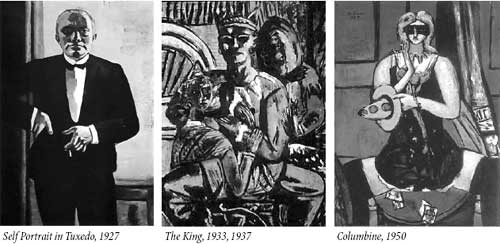Fourth Way Perspectives
Art Review
Max Beckmann
Artist in Search of the Self
Ultimately, all seeking and aspiration end in finding yourself, your real self, of which your present self is only a weak reflection.
—Max Beckmann
Ouspensky says in Search, "I had come to the conclusion a long time ago that there was no escape from the labyrinth of contradictions in which we live except by an entirely new road. But where this new or forgotten road began I was unable to say." But he does know, as he says, that "beyond the thin film of false reality there existed another reality. The 'miraculous' was a penetration into this unknown reality."
The painter Max Beckmann puts it this way: "What I want to show in my work is the idea which hides itself behind so-called reality. I am seeking for the bridge which leads from the visible to the invisible, like the famous cabbalist who once said: 'If you wish to get hold of the invisible, you must penetrate as deeply as possible into the visible.' To penetrate is to go through."
A contemporary of Ouspensky, Beckmann also lost a father when he was very young, dropped out of school at the age of 15 in his quest to discover the reality that lay beyond the surface of things. Both men were gifted, determined and headstrong.
Both were influenced by Nietzsche and Kant. They differed only in the road they took to penetrate beyond the surface of life. Ouspensky's way of penetration was first Theosophy and then the ancient esoteric teaching of the Fourth Way. Beckmann's was through painting. In his essay "On My Painting," he speaks of the self as "the great veiled mystery of the world." He sees it as his task "to find the self, which has only one form and is immortal—to find it in animals and men, in the heaven and in the hell which together form the world in which we live." It is his opinion, he says, that "all important things in art since Ur of the Chaldeans, since Tell Halaf and Crete, have always originated from the deepest feeling about the mystery of Being. Self-realization is the urge of all objective spirits. It is this self that I am searching in my life and my art."

In his pursuit of the hidden self, Beckmann comes to see that "Its path is, in some strange and peculiar manner, our path. And for this reason I am immersed in the phenomenon of the Individual, the so-called whole Individual, and I try in every way to explain and present it. What are you? What am I? These are the questions that incessantly hound and torment me, but which also perhaps contribute to my artistic efforts."
Painting, for Beckmann, was a way of exploration and discovery, extending his consciousness deeper and deeper into the subconscious realms. And so his paintings are often disturbing and demanding, taut and ripe with the tension of opposites. They put the viewer in question, not intellectual question, or question as some sort of conceptual or perceptual game. He aims at the primal, the mythic. He held modern art in low esteem. "There is one thing that always happens in good art," he said. "This is the conjunction of artistic sensuality with the artistic objectivity and actuality of the things to be represented. Abandon this," he warned, "and you inevitably fall into the domain of applied arts."
While he revered Cézanne and admired Van Gogh he had little use for Gauguin and his followers. "I do not regard Gauguin as a world-shattering innovator, but as a person of taste who succeeded in assembling a momentarily diverting décor out of Cézanne and tropical-island motifs. What I find feeble about him is his dependency on ancient, primitive styles, which in their own time had grown organically out of a shared religion and a shared, mystical, folk consciousness. Feeble, because he was not capable of extracting from our own time—murky and fragmented though it may be—types that might be for us, the people of the present, what gods and heroes were for those people then." As for Matisse and Picasso, he says, "Matisse is an even more deplorable representative of this ethnology museum art: the Asian department. Even this he gets at second-hand from Gauguin and Munch....Not until the combined forces of pure and applied art have spent another ten years churning out their framed Gauguin wallpapers, Matisse fabrics, Picasso chessboards, and Siberian-Bavarian folkicon posters will they realize, perhaps, that genuinely new personalities do exist—but that they have never, alas, been all that modern or contemporary. I say new personalities intentionally, for that is the only new thing there is. The laws of art are eternal and unchangeable, like the moral law within us."